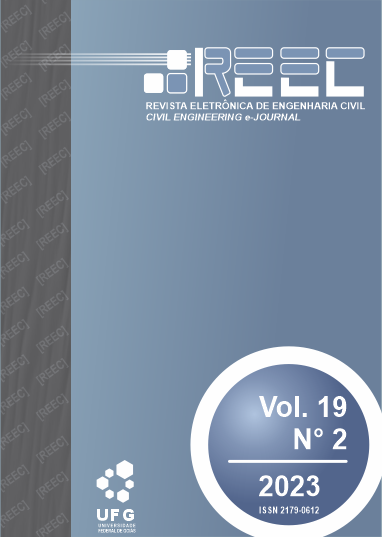Usage research of construction inspection sheet in Goiania companies
DOI:
https://doi.org/10.5216/reec.v19i2.71137Keywords:
Digitals Construction Sites, Digital Technologies, Quality Inspection, Industry 4.0, ProductivityAbstract
In the last few years, especially in the current pandemic context, there has been an evolution of interest in the use of digital technologies on construction sites, such as the growth of actions aimed at the adoption of BIM, initiatives aimed at training professionals to carry out projects and constructions, and discussions around the integrated use of digital technologies. The Digital Construction Inspection Sheet (CIS) is one of these technologies, being a tool to control and manage the services performed more effectively when compared to traditional sheets. Thus, the objective of this work is to study, through interviews via Google meet and site visits, the use of this technology by some companies in Goiânia, surveying the motivations, difficulties, adaptability and the gains they had by implementing digital CIS in their sites. By analyzing the answers of the interviewees, both in online meetings and on site visits, it is notable that the digital VVS can solve many of the problems of control and management of the services performed on site, such as the agility of the inspections, the ease of viewing and controlling the data obtained, and the reduction in the volume of paper generated, but there are still some conflicts between the technology and its users and the sector, such as problems in the assimilation of the tool by some users and the fulfillment of the platforms themselves.
Downloads
References
ANVERSA, G.B. Machine Learning e seus usos na construção. Sienge Plataforma, 2020. Publicado em 17/04/2020. Acesso em 02/04/2021. Disponível em: https://www.sienge.com.br/blog/machine-learning-e-seus-usos-na-construcao/
BALTLETT, K.; BLANCO, J. L.; FITZGERALD, B.; JOHNSON, J.; MULLIN, A. L.; RIBEIRINHO, M. J. Rise of the platform era:
The next chapter in construction technology. Publicado em 30/10/2020. Acesso em 02/04/2020. Disponível em: https://www.mckinsey.com/industries/private-equity-and-principal-investors/our-insights/rise-of-the-platform-era-the
-next-chapter-in-construction-technology
BÖES, J. S.; PATZLAFF, J. O.; GONZÁLEZ, M. A. S. Estudo sobre a gestão da informação no controle de qualidade de obras: Uma análise da aplicabilidade da tecnologia da informação e comunicação (TIC). In: XVI Encontro Nacional de Tecnologia do Ambiente Construído. ENTAC: São Paulo, 2016. Disponível em: https://www.researchgate.net/publication/320259436_Estudo_sobre_a_gestao_da_informacao_no_controle_de_qual idade_de_obras_uma_analise_da_aplicabilidade_da_tecnologia_da_informacao_e_comunicacao_TIC/. Acesso em: 05/10/2021.
BRYNJOLFSSON, E.; MCAFEE, A. The Second Machine Age: Work Progress and Prosperity in a Time of Brilliant Technologies. 1° ed. New York: W. W. Norton, 2014.
CONFEDERAÇÃO NACIONAL DA INDÚSTRIA. Indústria 4.0 Modo Covid-19: Uma análise de tendências, tecnologias, startups e atividades que definem a indústria 4.0 relacionada à COVID-19. Brasil, 2020.
CROTTY, R. The Impact of Building Information Modelling. SPON Press. Nova Iorque, 2012.
DUTTON, W. H. Computers and Society. In: International Encyclopedia of the Social & Behavioral Sciences, 2001. Information and Communication Technologies. ScienceDirect. Disponível em: https://www.sciencedirect.com/topics/computer-science/information-and-communication-technologies/. Acesso em: 05/10/2021.
ERICKSON, B. J.; KORFIATIS, P.; AKKUS, Z.; KLINE, T. L. Machine Learning for Medical Imaging. RadioGrafics, Vol. 37, N°2. Radiological Society of North America, 2017.
FUNDAÇÃO INSTITUTO ADMINISTRAÇÃO. Tecnologia na Construção Civil: o que é, importância e exemplos. FIA, 2020. Disponível em: https://fia.com.br/blog/tecnologia-na-construcao-civil/. Acesso em: 20/07/2021.
FIRJAN. Indústria 4.0. Cadernos SENAI de Inovação, Abril 2016.
GANDOMI, A., HAIDER, M. Beyond the hype: Big data concepts, methods, and analytics. In: International Jornal of Information Management. Vol. 35, Issue 2. Elsevier Ltd: 2015. pp. 137-144. Disponível em: https://doi.org/10.1016/j.ijinfomgt.2014.10.007. Acesso em: 05/10/2021.
GIL, A. C. Métodos e técnicas de pesquisa social. 6° ed. São Paulo: Atlas, 2008.
HARTY, J.; KOUIDER, T.; PATERSON, G. Getting to grips with BIM: a guide for small and medium-sized architecture, engineering and construction firms. 1° ed. Abingdon: Routledge, 2016.
IRIZARRY, J.; COSTA, D. B. Exploratory study of potential applications of unmanned aerial systems for construction management tasks. Journal of Management in Engineering, v. 32, n. 3, p. 05016001, 2016.
LI, X.; YI, W.; CHI, H.-L.; WANG, X.; CHAN, A. P. C. A critical review of virtual and augmented reality (VR/AR) applications in construction safety. Automation in Construction, v. 86, p. 150-162, fev. 2018. disponível em <http://dx.doi.org/10.1016/j.autcon.2017.11.003>.
MASOTTI, L.F.C. Análise da implementação e do impacto do bim no Brasil. 2014. TCC(bacharel em Engenharia Civil)-Universidade de Santa Catarina,Florianópolis:2014.
MINISTÉRIO DAS CIDADES. Regimento Geral-Regimento Específico da Especialidade Técnica Execução de Obras, PBQP-H - Programa Brasileiro de Qualidade e Produtividade no Habitat. Brasília: 2017.
MONTALVÃO, A. C. P. S. Estudo da Conversão de polarização linear-circular em antenas dual-band para leitores RFID portáteis usando metasuperfícies miniaturizadas. 2016. 193 f. Tese (Doutorado em Engenharia Elétrica e de Computação) - Universidade Federal do Rio Grande do Norte, Natal: 2016.
MOREIRA, A. C. Diretrizes para proposição de um modelo lógico baseado na Web Orientação: Aplicação voltada à rastreabilidade e recuperação de informação na Construção Civil / Adriano Castro Moreira - 2017.
NASCIMENTO, L. A. do; SANTOS, E. T. Barreiras do uso da tecnologia de informação na indústria da construção civil. In: WORKSHOP NACIONAL DE GESTÃO DO PROCESSO DE PROJETO NA CONSTRUÇÃO DE EDIFÍCIOS, 5., 2002, Porto Alegre. Anais… PORTO ALEGRE: PUCRS, 2002.
PEDO, B.; BRANDALISE, F.M.P.; VIANA, D. D.; TZORTZOPOULOS, P.; FORMOSO, C. T.; WHITELOCK-WAINWRIGHT, A.
Digital Visual Management Tools in Design Management. In: Proc. 28th Annual Conference of the International Group for Lean Construction (IGLC28). Califórnia: Berkeley, 2020. Disponível em: doi.org/10.24928/2020/0071. Acesso em: 04/04/2021.
REMONDINO, F.; EL-HAKIM, S. Image-based 3D modelling: A review. The Photogrammetric Record, 21(115), p. 269-291, set. 2006.
SALEHI, H.; BURGUENO, R. Emerging artificial intelligence methods in structural engineering. Engineering Structures, p. 171, 2018.
SANTOS, M. K.; FERREIRA JÚNIOR, J. R.; WADA, D. T.; TENÓRIO, A. P. M.; BARBOSA, M. H. N.; MARQUES, P. M. A.
Inteligência Artificial, Aprendizado de Máquina, Diagnóstico Auxiliado por computador e radiônica: Avanços da imagem rumo à medicina de precisão. Radiol Bras, São Paulo, v. 52, n. 6, p. 387-396, Dec. 2019. Disponível em
<http://www.scielo.br/scielo.php?script=sci_arttext&pid=S0100-39842019000600011&lng=en&nrm=iso>. Acesso em 02/04/2021.
SCHIA, M. H.; TROLLSÅS, B. C.; Fyhn, H.; Lædre, O. (2019). The Introduction of AI in the Construction Industry and its Impact on Human Behavior. In: Proc. 27 th Annual Conference of the International. Group for Lean Construction (IGLC), Pasquire C. and Hamzeh F.R. (ed.), Dublin, Ireland, pp. 903-914. DOI: https://doi.org/10.24928/2019/0191. Available at:
SELLTIZ, C.; WRIGHTSMAN, L. S.; COOK, S. W. Métodos de pesquisa nas relações sociais. 1° ed. São Paulo: EPU, 1965.
SERVIÇO BRASILEIRO DE APOIO ÀS MICRO E PEQUENAS EMPRESAS. Construção Civil: Relatório de Inteligência Agosto/2017. Brasil, 2017.
SILVA, L. T. E. e; SOUSA, T. V. de; SILVA, V. V. da; AMARAL, T. G. do. Tecnologias digitais utilizadas pela indústria da construção civil. In: XII SIBRAGEC. Antac: Maceió, 2021.
TIXIER, A. J.-P.; HALLOWELL, M. R.; RAJAGOPALAN, B.; BOWMAN, D. Application of machine learning to construction injury prediction. Automation in Construction, Volume 69, 2016. (PA.102-114).
WING, R. RDIF Applications in Construction and Facilities Management. ITcon Vol. 11. Journal of Information Technology in Construction, 2006. (pag. 711-721)
ZIKMUND, W. G.; BABIN, B. J.; CARR, J. C.; GRIFFIN M. Business research methods. 8° ed. Iowa City: South-Western College Pub.
Downloads
Published
How to Cite
Issue
Section
License
Autores que publicam nesta revista concordam com os seguintes termos: Autores mantém os direitos autorais e concedem à revista o direito de primeira publicação, com o trabalho simultaneamente licenciado sob a Licença Creative Commons Attribution que permite o compartilhamento do trabalho com reconhecimento da autoria e publicação inicial nesta revista.
![[REEC] Revista Eletrônica de Engenharia Civil](https://revistas.ufg.br/public/journals/30/pageHeaderLogoImage_pt_BR.png)



